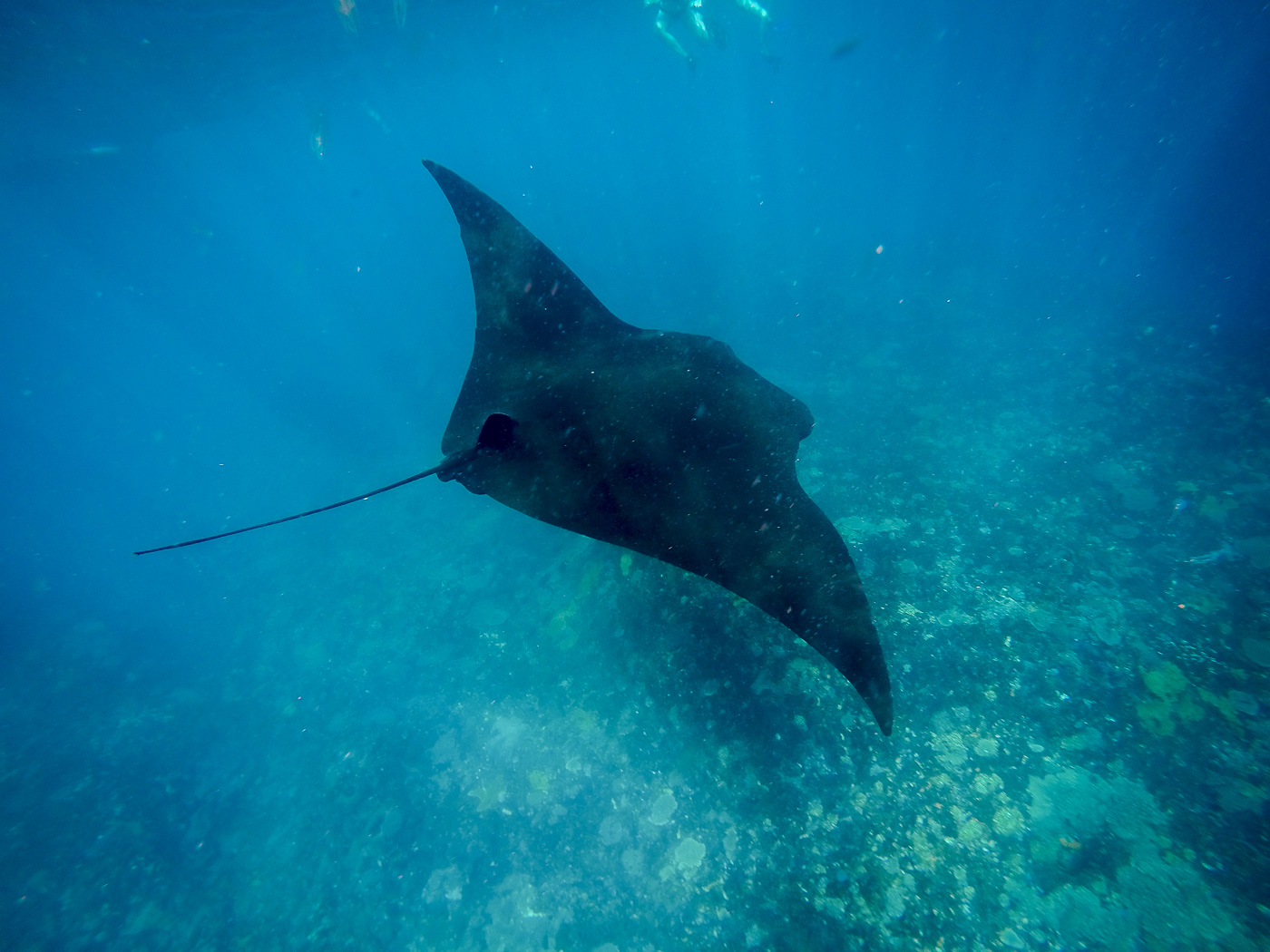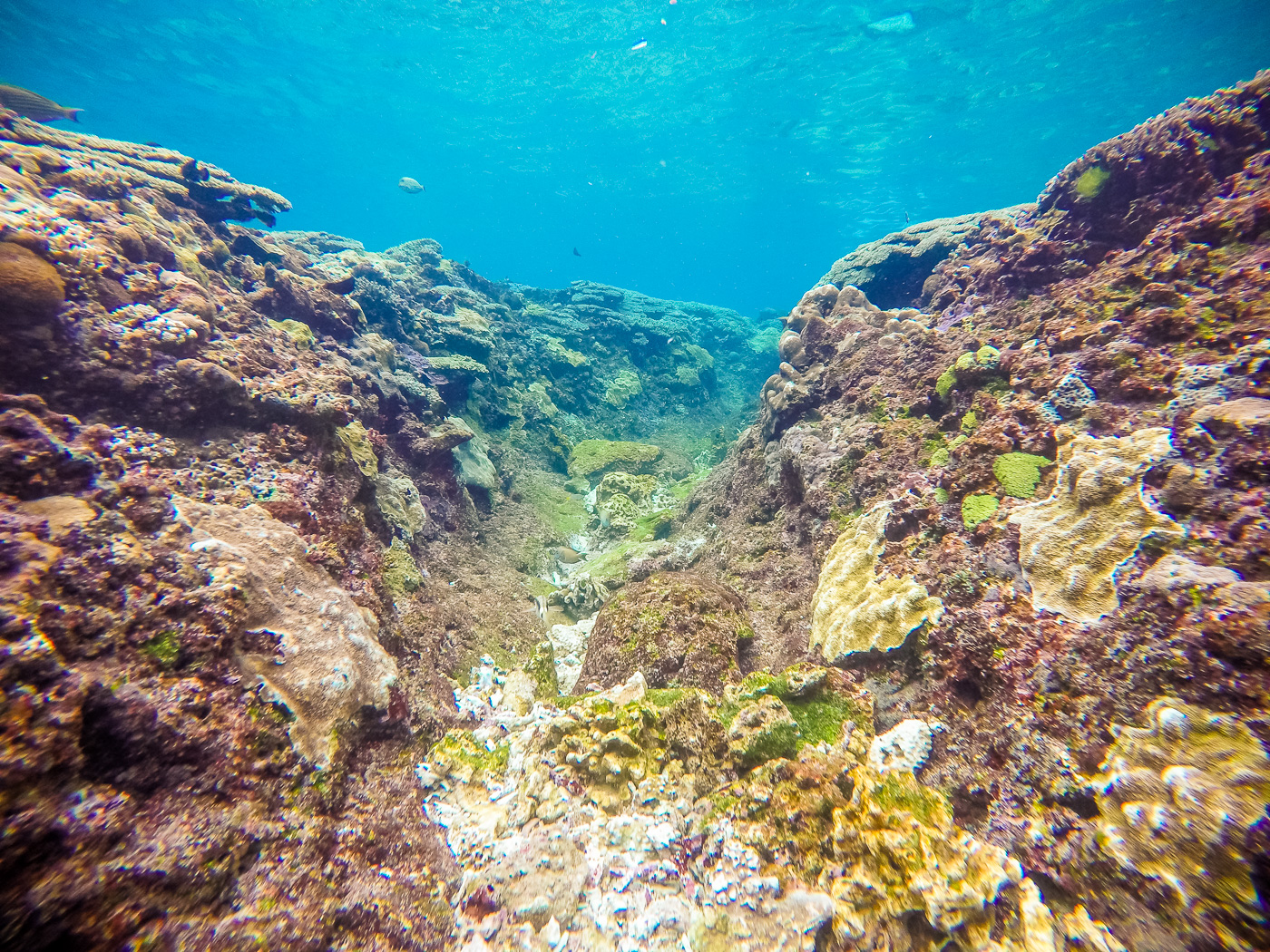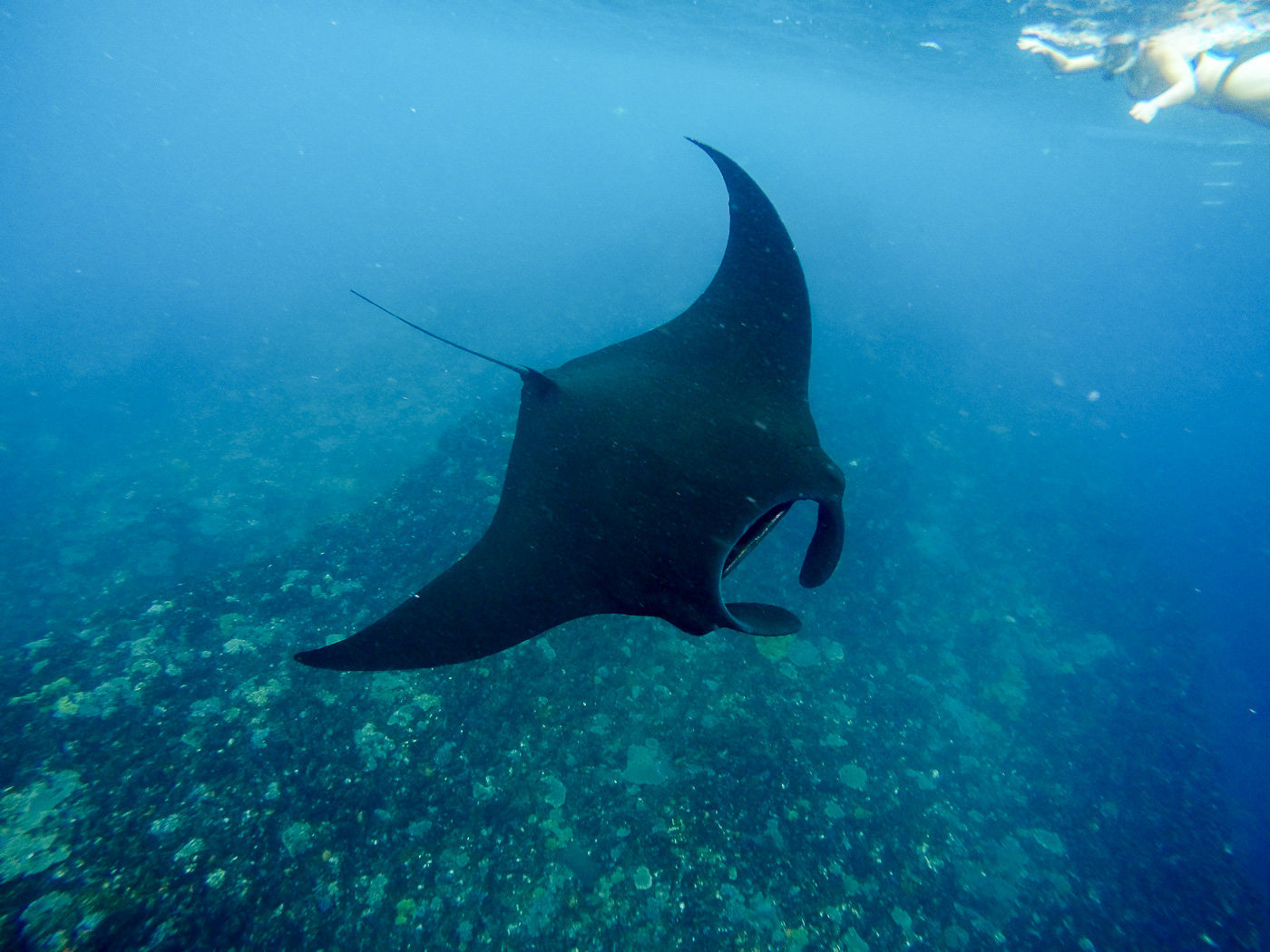The shorelines on Nusa Penida’s Manta Bay are dramatic limestone cliffs that have been etched away slowly and harshly by the sea. Underwater this vertical rock face extends for meters below at points making it difficult to discern the ocean bottom. Its waters are teeming with small pink, white and translucent jellyfish propelling themselves every which way in jerky up and down motions. This plankton filled cove happens to be prime feeding ground for Indonesia’s great manta rays and thus has become a major Balinese scuba diving destination.
We too initially came to Nusa Lembongan, and its neighboring islands Nusa Penida and Nusa Ceningan, with the intention of continuing our underwater adventures scuba diving. These three small, sparsely inhabited islands only a 30-minute boat ride from Southern Bali are home to scores of spectacular underwater life. However after Adam came down with a cold and with our Indonesia travel budget running low thanks to the cost of our Open Water Dive Certification on Gili Air and subsequent USAT Liberty wreck dive in Tulamben, we decided instead to trade our regulators for snorkels in the hopes of scoring an opportunity to swim with these gentle giants closer to the ocean’s surface.
We organized our half-day snorkeling trip with a local PADI certified dive master named Diasa who also happened to own the D&B Homestay we were staying at. Our adventure turned out to be an awesome half-day of snorkeling fun at Nusa Penida’s Manta Bay and Crystal Bay and Nusa Lembongan’s Mangrove Point.
 Manta Rays at Manta Point
Manta Rays at Manta Point
After a windy 20-minute boat ride from Nusa Lembongan’s main beach, we arrive at the limestone cliffs of the remote Nusa Penida. With the sun hiding behind the clouds, the vibrant turquoise blue water takes on a darker mysterious tone. Despite the lack of sunlight, Captain Diasa and his boat lieutenant know how to spot the mantas. They spend 10 minutes circling the coves paying close attention to the base of the cliffs.
Suddenly a spotting. The flap of a wing emerges on the surface than quickly disappears.
“It’s there, it’s there. A manta. Get into the water!” Diasa instructs us with an air of urgency to get our snorkel, mask and fins on and jump in at once.
We frantically scramble to put our gear on as he insists that we get into the water immediately. With how long it took to spot one, we know this may be our only shot at seeing a great manta today. Into the water we dive, shocked at once by its unexpected coldness (22 degrees Celcius). Masks on we can now see below us. Along with the murky film of plankton the mantas love so much there were hoards of small opaque white jellyfish propelling themselves in jerky up and down motions near the surface of the water. We had dropped ourselves into the perfect manta ray feeding ground! Occasionally the quick sting of the jelly fish sends a jolt through our bodies; a light but tolerable pain lingers on the skin.
Through the depths a dark figure starts to emerge. It’s indiscernible at first but impossible to miss and its headed straight towards us! As the manta ascends towards the surface we get our first glimpse of his great white underbelly. His expansive gray wings flap gracefully at his sides. The manta is a massive creature, measuring up to seven and a half meters wide (25 feet). This one, Diasa tells us, is really big – possibly five meters. I have no point of reference to know for sure.
We can’t make out his eyes but he can clearly see us. With one maneuver he changes course and dives beneath us, circling first then disappearing into the murky waters.
Convinced the manta is not planning on returning after several more long minutes in the jellyfish mine field, Diasa instructs us to get out of the water and back into the boat. We are happy to oblige for the time being.
While Diasa continues searching we remain hopeful this won’t be our only sighting for the day. We are greedy after all and our encounter was far too brief. We wanted more time with this underwater gentle giant. To keep our expectations in check we had to remind ourselves about our bleak experience cage diving with great white sharks in South Africa. We should count ourselves lucky to even see one manta.
Then another wing appears at the surface of the water some 10 meters from our boat. This time we are ready with camera and snorkel gear and plunge ourselves quickly back into the water.
A beautiful all black manta has come to feed. Unlike the first, she is curious about us strange flailing creatures interrupting her breakfast. Diasa instructs us to stay where we are, not to swim after her but to float on the surface and let her approach us. Sure enough she makes several passes around us, at times swimming out of our view but always coming back. She moves with the grace of an underwater gymnast, gently flapping her wings in calculated and perfectly timed motions. Her movements are hypnotic.
With her departure, a new pair of smaller white and gray mantas appear allowing Adam the opportunity to dive down and capture them at a closer distance before splitting apart and moving in separate directions.
Mantas are intelligent – they have the largest brain to body ratio of all ray and shark species. Despite their intimidating size, they are also incredibly gentle so it is not a scary experience being in their presence. Swimming with the mantas, watching them make slow and calculated movements as they come at us head on before dodging around or below we get a sense of this intelligence and curiosity. If you ever have the opportunity to swim with mantas, don’t pass it up!
All too soon it is over. The mantas have fled to the shelter of a neighboring cove. Unfortunately for them there are now five other boats full of snorkelers chasing them down, swimming frantically after them for the opportunity to get their own look. We count ourselves lucky to have had as much time as we did with four of these beautiful animals.
 Crystal Bay
Crystal Bay
Our next snorkeling stop was Crystal Bay, a shallow coral reef with few pelagic fish but hoards of smaller reef fish and beautiful corals. Crystal Bay has escaped the dynamite and cyanide fishing that unfortunately has plagued so many of Southeast Asia’s other reefs. Its reefs are beautifully pristine and the clear shallow waters allow us the opportunity to admire them up close. While we didn’t have our underwater camera housing unit this day, don’t let the mediocre photographs fool you — this was an incredible, beautiful experience.
We let the strong currents of Crystal Bay drift us from one cove to another, being mindful not to venture too close to the rocky cliff faces where strong underwater currents have been known to sweep up many an unsuspecting snorkeler. Fish we had only seen one or two of on previous scuba dives we are now swimming with in groups of a dozen. The Moorish Idols frolic in and out of the reefs as the brilliant turquoise parrot fish using their teeth to peck at the coral. Countless butterfly fish, emperor angelfish, triggerfish and puffers swim slowly along in the current. Naturally formed ridges amongst the coral make for the perfect swimming passageways allowing us to dive down and swim less than half a meter to the corals.
Thirty minutes in the water and I am starting to shiver. So we load up and move on to our next spot, Mangrove Point.
Mangrove Point
It’s mid-morning when we arrive at our final stop on our snorkeling excursion, Mangrove Point located on the northern tip of Nusa Lembongan. Deeper than Crystal Bay with intensely clear water visibility and no current, we are able to swim freer, dive deeper and enjoy a calm 30 minutes amongst the playful schools of fish. The always-jolly orange and white stripped clownfish tickle themselves among the anemone. An trumpet fish takes shelter beneath large coral cove. Adam and I take turns diving to get a closer swim with the emperor angelfish.
A solid morning of snorkeling complete, we head back to Nusa Lembongan’s main beach chipper about our swim with the fishes.
Nusa Lembongan Snorkeling
Similar to our experience snorkeling Los Tuneles in the Galapagos, snorkeling on Nusa Lembongan and Nusa Penida was worth every rupiah. I really loved Diasa at D&B Warung — he was professional and safe and showed a real concern for the well-being of the mantas.
Divers and snorkelers, if you are heading to Bali, you’d be crazy not to make a detour over to Nusa Lembogan. When you’re there tell the mantas that we say hello.
If You Go:
What: Half-day snorkeling trips are widely available departing from Nusa Lembongan. We stayed at D&B Lembongan. The local owner of this homestay and warang, Diasa, is a PADI Certified Dive Master who now leads small group snorkeling tours. You don’t have to be a guest at D&B to organize the tour with him. He runs tours daily.
Where: Our favorite part of our snorkeling adventure was hands down swimming with the mantas of Manta Bay on the farthest and most remote island Nusa Penida. Typical snorkeling excursions will pair Manta Bay with stops at Crystal Bay and Mangrove Point.
When: All year round! Mantas can be seen all year round in the south of Nusa Penida. The waters around sites like Manta Point are full of plankton and jelly fish and this can attract sometimes seven or eight mantas at a time.
How: D&B own a small fishing and snorkeling boat that they use to transport up to 8 passengers around the islands to the prime snorkeling spots.
Cost: Our snorkeling excursion cost 200,000 IDR (US$15) per person.

































